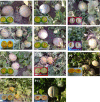Inheritance of fruit yield and quality in melon (Cucumis melo L.) grown under field salinity stress
- PMID: 31076605
- PMCID: PMC6510772
- DOI: 10.1038/s41598-019-43616-6
Inheritance of fruit yield and quality in melon (Cucumis melo L.) grown under field salinity stress
Abstract
Cultivation of salinity-tolerant crops can help mitigate salinization threats to soil and fresh water resources. This study was conducted to investigate the quantitative genetic basis of yield, yield components, and quality-related traits of salinity-stressed melon (Cucumis melo L.) using 55 melon hybrids and their 11 parents (half diallel). The results of combined ANOVA revealed highly significant effects of salinity and genotype on all the traits studied. Salinity stress influenced the inheritance of all the traits. The lower values of variance components (mainly additive), GCA/SCA ratio, as well as broad- and narrow-sense heritabilities were estimated for saline conditions (ECW = 14 dSm-1) when compared with those obtained under non-saline conditions. Fruit weight was governed by additive effects in non-saline conditions, but largely governed by the dominant nature in saline conditions. Based on the results obtained, especially as reflected by fruit yield, it is possible to develop melon hybrids with higher salinity tolerance than is currently observed in tolerant cultivars. On the other hand, most of the traits contributing to fruit quality are found to be governed by additive effects, allowing for their further improvement through recurrent selection to develop new cultivars of high yield and good quality for cultivation under saline conditions.
Conflict of interest statement
The authors declare no competing interests.
Figures


References
-
- Arzani A, Ashraf M. Smart engineering of genetic resources for enhanced salinity tolerance in crop plants. Crit. Rev. Plant Sci. 2016;35:146–189. doi: 10.1080/07352689.2016.1245056. - DOI
-
- Food and Agriculture Organization (FAO). Food and Agricultural Organization of the United Nations. FAOSTAThttp://www.fao.org/faostat/en/#data/QC (2018).
-
- Food and Agriculture Organization (FAO). Global network on integrated soil management for sustainable use of salt-affected soils. country specific salinity issues—Iran. FAO, Rome, http://www.fao.org/ag/agl/agll/spush/degrad.asp?country=iran (2000).
-
- Qadir M, Qureshi AS, Cheraghi SAM. Extent and characterisation of salt-affected soils in Iran and strategies for their amelioration and management. Land. Degrad. Dev. 2008;19:214–227. doi: 10.1002/ldr.818. - DOI
-
- Mangal JL, Hooda PS, Lal S. Salt tolerance of five muskmelon cutivars. J. Agric. Sci. 1988;110:641–643. doi: 10.1017/S0021859600082241. - DOI
Publication types
MeSH terms
LinkOut - more resources
Full Text Sources

